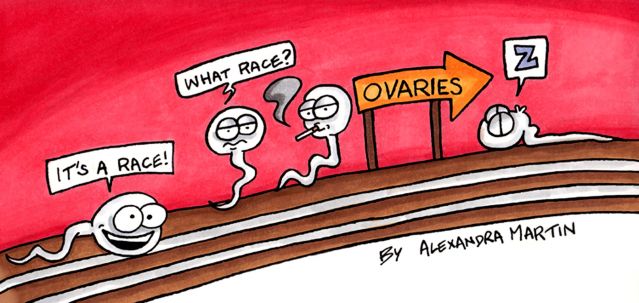
In The Children of Men, mystery author P.D. James imagines a future world, just eight years from now, in which the entire human population has become infertile and the last people born are all adults. Sperm counts have fictionally crashed to zero, threatening humankind with extinction. That theme was taken up in a similarly-titled but loosely related film starring Julianne Moore and Clive Owen. Of course, such doomsday scenarios involving plunging sperm counts reside in the world of fiction. Or do they?
First Indications
In 1974, fertility experts Kinloch Nelson and Raymond Bunge examined semen specimens from almost four hundred American men who had requested vasectomy (severing of their sperm-carrying ducts) as a contraceptive measure. Over the five-year period 1968-1972 the average sperm count per ejaculate for men undergoing vasectomy was less than 140 million. Nelson and Bunge realized that this was far below the counts reported by earlier investigators, who had generally reported an average of over 300 million sperms per ejaculate.
The startling difference between those earlier results and their own prompted Nelson and Bunge to review previous semen analyses from four hundred men who had attended their own hospital for infertility evaluation some time previously, between 1956 and 1958. A quarter of them had total sperm counts exceeding 300 million. After carefully considering alternative explanations, Nelson and Bunge concluded that some unknown factor had led to a remarkable depression in semen quality of fertile men. Their paper and several similar reports sparked a lively and continuing controversy regarding the disturbing prospect that human sperm counts have fallen drastically since the 1950s.
Statistical Surveys
Scientists on both sides of the debate based their arguments on data from a few large samples examined at different times and often in different places. Eventually, William James—a biologist renowned for his many careful statistical investigations of human reproduction—stepped in to test whether there really was a trend in reported sperm counts. He tracked down representative data on average sperm counts of unselected men over a 45-year period and presented his results in 1980. His conclusions were unequivocal: “There can be no reasonable doubt that the reported mean sperm counts show a decline with time of publication, at least since 1960.” Following James’ paper, reports of declining sperm counts continued to stack up around the world.
In a key paper published in the British Medical Journal in 1992, Danish reproductive biologist Elisabeth Carlsen and associates reported results from a combined analysis of previously available data. Altogether, they reviewed sixty-one papers published between 1938 and 1991, covering a total of 15,000 men with no history of infertility (predominantly in Europe and North America). Carlsen and her team carefully allowed for various possible sources of bias. The outcome was that average sperm concentration had declined by almost half over the fifty-year period 1940-1990. This decrease was compounded by a twenty percent decline in average ejaculate volume. Even more alarmingly, decreasing sperm counts were paralleled by increasingly frequent medical problems with the male reproductive system. These include undescended testes (cryptorchidism), penis malformation and testicular cancer, which has increased worldwide.
British epidemiologist Clair Chilvers and colleagues had already reported in 1984 that the incidence of cryptorchidism had approximately doubled over two decades, while other reports showed that the incidence of testicular cancer approximately tripled over the fifty-year period examined by the Carlsen team. This raises the specter that the factors responsible for decreasing sperm counts may be having increasingly serious impacts on the male sex organs themselves. As testimony to a possible link, the Carlsen team noted that in Danish men the incidence of testicular cancer was five times higher than in Finnish men, whereas their sperm counts were more than forty percent lower. Recently, it has been found that sperm counts have now begun to decline in Finnish men as well, and testicular cancer has increased in tandem.
Controversy Flares
Not unexpectedly, worldwide attention to the 1992 report by Carlsen and colleagues sparked criticism from several quarters. For instance, in a letter published later that same year, also in the British Medical Journal, obstetrician Ian Tummon and reproductive biologist David Mortimer questioned the validity of the results. They noted that the reliability of semen analyses and quality control might have changed over the years, and claimed that there was no trend, just a downward shift in results obtained before and after 1961. Their parting shot was: “The greenhouse effect, global warming, declining sperm counts—all may be true; we just do not know.” Well, the weight of scientific evidence now clearly documents the greenhouse effect and global warming, so perhaps we should not be too surprised if declining sperm counts follow suit. Regardless of the outcome of the ongoing debate, the available evidence is surely enough to prompt a re-reading of The Children of Men.
(The second part of this discussion, evaluating more recent studies on declining sperm counts, will be posted in the next blog.)
References
Carlsen, E., Giwercman, A., Keiding, N. & Shakkebaek, N.E. (1992) Evidence for decreasing quality of semen during past 50 years. Brit. med. J. 305:609-613.
Chilvers, C., Pike, M.C., Forman, D., Fogelman, K. & M. Wadsworth, E.J. (1984) Apparent doubling of frequency of undescended testis in England and Wales in 1962–81. Lancet 324, 330–332.
James, W.H. (1980) Secular trend in reported sperm counts. Andrologia 1, 381-388.
Nelson, C.M.K. & Bunge, R.G. (1974) Semen analysis: evidence for changing parameters of male fertility potential. Fertil. Steril. 25, 503-507.
Tummon, I.S. & Mortimer, D. (1992) Decreasing quality of semen Brit. Med. J. 305, 1228-1229.


